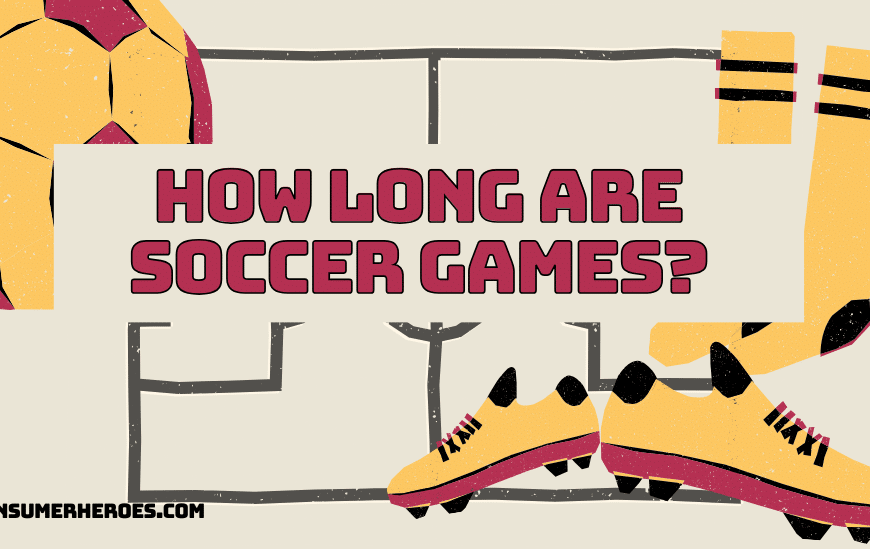Soccer, also known as football, is a popular sport worldwide. It is played by millions of people of all ages and skill levels. One question that often arises among new fans or those unfamiliar with the game is, “How long is a soccer game?” The answer is not as straightforward as one might think.
In general, a soccer game consists of two halves, each lasting 45 minutes, with a 15-minute halftime break in between. This means that the total duration of a soccer game is 90 minutes. However, there are some exceptions to this rule. For example, in youth leagues or friendly matches, the game may be shortened to two 30-minute halves or even four 15-minute quarters. Additionally, in professional matches, extra time may be added to the end of the game if there is a tie at the end of regulation time.
Understanding the length of a soccer game is important for both players and fans alike. Players need to be able to pace themselves and maintain their energy levels throughout the game, while fans need to plan their schedules accordingly to ensure they don’t miss any of the action. Whether you’re a seasoned soccer player or a new fan, knowing the duration of a soccer game is a crucial piece of information.
Duration of a Soccer Game
Soccer is a sport that is loved and played by millions of people around the world. It is a game that is played for a set amount of time, and the duration of a soccer game can vary depending on the level of play and the competition. In this section, we will discuss the different aspects of the duration of a soccer game.
Regulation Time
The regulation time of a soccer game is 90 minutes. This is divided into two halves of 45 minutes each. During this time, the clock runs continuously, and the game is played without any interruptions, except for injuries or other unforeseen circumstances. The referee keeps track of the time and can add extra time at the end of each half to make up for any time lost due to injuries or other stoppages.
Half Time
After the first 45 minutes of play, there is a 15-minute half-time break. During this time, the players leave the field, and the coaches have an opportunity to speak to their teams and make any necessary adjustments. The half-time break is an essential part of the game, as it allows the players to rest and recover before the second half.
Extra Time
In some competitions, if the game is tied at the end of regulation time, extra time may be played. This is an additional 30 minutes, divided into two halves of 15 minutes each. If the game is still tied after extra time, a penalty shootout may be used to determine the winner.
Overall, the duration of a soccer game can vary depending on the level of play and the competition. However, the regulation time is 90 minutes, divided into two halves of 45 minutes each, with a 15-minute half-time break. Extra time may be played if the game is tied at the end of regulation time.
Factors Influencing Game Length
Soccer games are typically 90 minutes long, but the actual length of a game can vary depending on several factors. In this section, we will explore some of the factors that can influence the length of a soccer game.
Injuries
Injuries are a common occurrence in soccer, and they can significantly impact the length of a game. When a player is injured, the game is stopped while the player receives medical attention. The length of the stoppage can vary depending on the severity of the injury. In some cases, the player may need to be stretchered off the field, which can take several minutes. Once the injured player is off the field, the game can resume.
Substitutions
Teams are allowed to make up to three substitutions during a soccer game. When a substitution is made, the game is stopped while the player leaving the field is replaced by a new player. The length of the stoppage can vary depending on how quickly the players leave and enter the field. In some cases, the substitution can be completed in a matter of seconds, while in other cases, it can take several minutes.
Stoppage Time
Stoppage time is added to the end of each half of a soccer game to account for time lost due to injuries, substitutions, and other stoppages. The amount of stoppage time can vary depending on how much time was lost during the game. The referee is responsible for determining how much stoppage time to add, and this information is typically displayed on a board at the side of the field.
In conclusion, injuries, substitutions, and stoppage time can all influence the length of a soccer game. While the standard length of a game is 90 minutes, the actual length can vary depending on these and other factors.
Youth Soccer Game Duration
Youth soccer games typically have shorter durations than adult games. The length of a youth soccer game can vary depending on the age group and level of play. In general, younger age groups have shorter game times than older age groups.
Here are some common youth soccer game durations:
- Under 6 (U6): 2 halves of 10 minutes each
- Under 8 (U8): 2 halves of 20 minutes each
- Under 10 (U10): 2 halves of 25 minutes each
- Under 12 (U12): 2 halves of 30 minutes each
- Under 14 (U14): 2 halves of 35 minutes each
- Under 16 (U16): 2 halves of 40 minutes each
- Under 19 (U19): 2 halves of 45 minutes each
It is important to note that these durations are not set in stone and can vary depending on the league or tournament rules. Coaches and parents should always check with the league or tournament organizers to confirm the game duration.
In addition to game duration, youth soccer games may also have other rules that differ from adult games. For example, some leagues may use smaller fields or restrict the number of players on the field at one time. These rules are designed to make the game more enjoyable and safe for young players.
Women’s Soccer Game Duration
Like men’s soccer, women’s soccer games have two halves. However, the duration of each half is different from men’s soccer games. Women’s soccer games have a duration of 45 minutes per half, making a total of 90 minutes of playtime.
In addition to the 90 minutes of playtime, there is also stoppage time added to each half. Stoppage time is added by the referee to account for any time lost due to injuries, substitutions, or any other interruptions during the game. The amount of stoppage time can vary depending on the referee’s discretion and can range from a few seconds to several minutes.
Unlike in some men’s soccer leagues, there are no additional periods of extra time or penalty shootouts in women’s soccer games that end in a tie. In knockout tournaments, such as the World Cup or Olympic Games, if a game ends in a tie, the winner is determined by a penalty shootout.
Overall, the duration of women’s soccer games is the same as men’s soccer games in terms of total playtime, but the duration of each half is different.
Conclusion
In conclusion, soccer games can vary in length depending on the level of play and the regulations of the governing body. Professional soccer games typically last for 90 minutes, divided into two 45-minute halves, with added time for stoppages. However, youth and amateur games may have shorter game times, such as 60 or 70 minutes.
In addition, the duration of soccer games can be influenced by factors such as weather conditions, injuries, and substitutions. For example, if a player is injured during the game, the referee may add extra time to make up for the stoppage. Similarly, if there are many substitutions, the referee may add extra time to ensure that the full 90 minutes are played.
It is important to note that soccer games can also be influenced by the rules of different leagues and tournaments. For example, some competitions may have extra time or penalty shootouts to determine a winner if the game ends in a tie. Therefore, it is always important to check the specific rules of the competition before attending or watching a soccer game.
Overall, soccer is a popular sport around the world, and understanding the length of a soccer game is important for both players and fans alike. By knowing the typical duration of a game, as well as the factors that can influence game length, soccer enthusiasts can better appreciate the intricacies of the sport and enjoy the game to its fullest.







